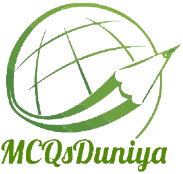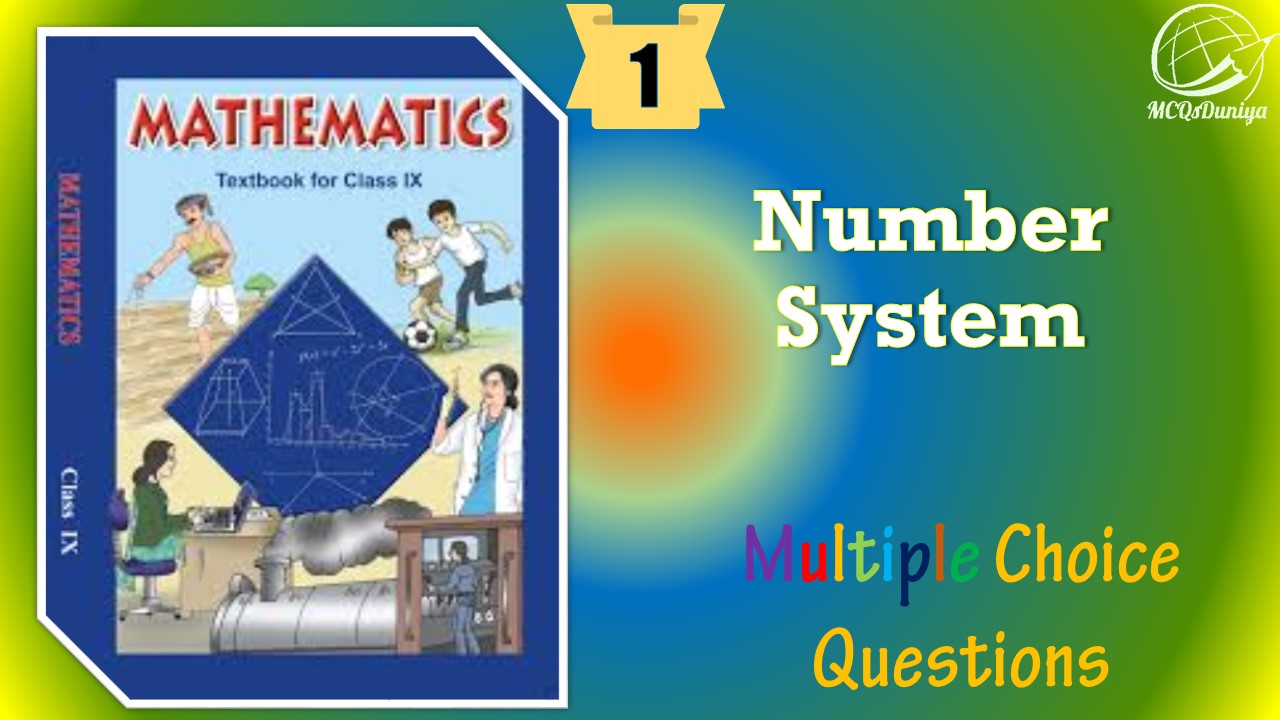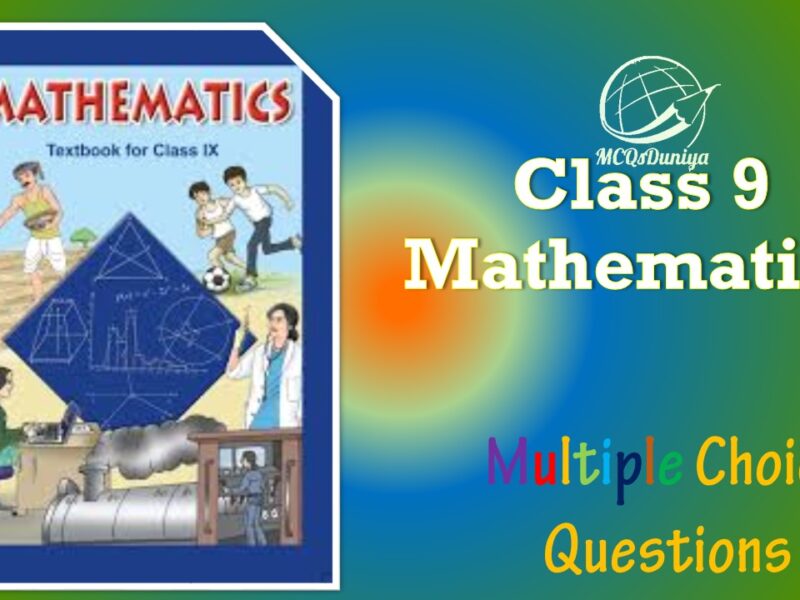Class 9 Mathematics MCQ Number System with Answers is Prepared Based on Latest Exam Pattern. Students can solve NCERT Class 9 Mathematics MCQ Number System with Answers to know their preparation level.
Students who are searching for NCERT Class 9 Mathematics MCQ Number System with Answers are compiled here to get good practice on all fundamentals. Know your preparation level on MCQ Questions for Class 9 Mathematics MCQ Number Systemwith Answers. You can also verify your answers from the provided Class 9 Mathematics MCQ Number System with Answers. So, ace up your preparation with MCQ of Class 9 Mathematics MCQ & NCERT Textbook solutions Examinations.
NCERT Class 9 Mathematics MCQ Number System with Answers
Question :Which of the following is the product of
(a)
(b)
(c)
(d)
Answer : (a) Show Answer :
Question :The decimal fraction in which there are finite number of digits in its decimal part is called
(a) terminating decimal fraction
(b) non-terminating decimal fraction
(c) linear fraction
(d) quadratic fraction
Answer : (a) terminating decimal fractionShow Answer :
Question :The product of a rational and an irrational numbers is:
(a) Always an integer
(b) Always a rational number
(c) Always an irrational number
(d) Sometimes rational and sometimes irrational
Answer : (c) Always an irrational numberShow Answer :
Question :In between two rational number there is/are:
(a) Exactly one rational number
(b) Infinitely many rational number
(c) Many irrational numbers
(d) Only irrational numbers
Answer : (b) Infinitely many rational numberShow Answer :
Question :The product of a rational and an irrational numbers is:
(a) Always an integer
(b) Always a rational number
(c) Always an irrational number
(d) Sometimes rational and sometimes irrational
Answer : (c) Always an irrational numberShow Answer :
Question :If the HCF of 65 and 117 is expressible in the form 65m – 117, then the value of m is
(a) 4
(b) 2
(c) 1
(d) 3
Answer : (b) 2Show Answer :
Question :Which of the following is a rational number?
(a) π
(b) 0
(c) 1+√3
(d) 2√3
Answer : (b) 0Show Answer :
Question :The HCF and LCM of two numbers are 33 and 264 respectively. When the first number is completely divided by 2 the quotient is 33. The other number is:
(a) 66
(b) 130
(c) 132
(d) 196
Answer : (c) 132Show Answer :
Question :Can we write 0 in the form of
(a) Yes
(b) No
(c) Cannot be explained
(d) None of the above
Answer : (a) YesShow Answer :
Question :3√6 + 4√6 is equal to:
(a) 6√6
(b) 7√6
(c) 4√12
(d) 7√12
Answer : (b) 7√6Show Answer :
Question :How many zeros after the decimal point will be there in the decimal form of the number 10-n ?
(a) n
(b) n+1
(c) n-1
(d)
Answer : (c) n-1Show Answer :
Question : The three rational numbers between 3 and 4 are:
(a) 5/2,6/2,7/2
(b) 13/4,14/4,15/4
(c) 12/7,13/7,14/7
(d) 11/4,12/4,13/4
Answer :(b) 13/4,14/4,15/4Show Answer :
Question : When 15√15 is divided by 3√3 find the quotient.
(a) 5√3
(b) 3√5
(c) 5√5
(d) 3√3
Answer :(c) 5√5Show Answer :
Question : (64)-3/2
(a) -1/512
(b) 1/512
(c) 64
(d) 1/64
Answer :(b) 1/512Show Answer :
Question : Find the remainder when 6799 is divided bt 7
(a) 1
(b) 6
(c) 4
(d) 2
Answer :(a) 1Show Answer :
Question : The Value of 4√3−4/√3+1 − 2−√3/ 2+√3
(a) 1
(b) 15
(c) 0
(d) None of these
Answer :(a) 1Show Answer :
Question : From the choices given below mark the co-prime numbers
(a) 2, 3
(b) 2, 4
(c) 2, 6
(d) 2, 110
Answer :(a) 2, 3Show Answer :
Question :A forester wants to plant 44 apples tree, 66 banana trees and 110 mango trees in equal rows (in terms of number of trees). Also, he wants to make distinct rows of tree (i.e. only one type of tree in one row). The number of rows (minimum) that required is:
(a) 2
(b) 3
(c) 10
(d) 11
Answer : (c) 10Show Answer :
Question :The rational number between 1 and 2 is
(a)
(b)
(c)
(d)
Answer : (a) Show Answer :
Question :Which of the following lies between 0 and -1?
(a) 0
(b) -3
(c)
(d)
Answer : (c) Show Answer :
Question :Expression of 2.2323… in the form of
(a)
(b)
(c)
(d)
Answer : (a) Show Answer :
Question :√6 × √27 is equal to:
(a) 9√2
(b) 3√3
(c) 2√2
(d) 9√3
Answer : (a) 9√2Show Answer :
Question : Which of the following numbers have terminating decimal expansion?
(a) 8/225
(b) 5/18
(c)11/21
(d) 21/21150
Answer 😀Show Answer :
Question : The descending order of the surds 3√2,6√3,9√4 is __.
(a) 9√4,6√3,3√2
(b) 9√4,3√2,6√3
(c) 3√2,6√3,9√4
(d) 6√3,9√4,3√2
Answer :CShow Answer :
Question :The product of two consecutive natural numbers is always _.
(a) An even number
(b) An odd number
(c) A prime number
(d) Divisible by 3
Answer :AShow Answer :
Question : The value of
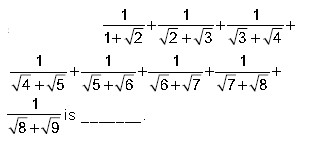
(A) 0
(b) 1
(c) 2
(d) 4
Answer :CShow Answer :
Question :The 100th root of 10(1010 ) is __.
(a) 10810
(b) 10108
(c) (√10)(√10)10
(c) 10(√10)√10
Answer :AShow Answer :
Question :The value of
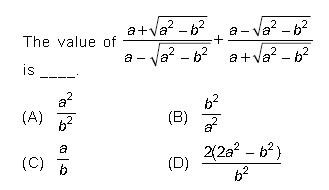
Answer :CShow Answer :
Question : A positive integer n when divided by 9, gives 7 as remainder. What will be the remainder when (3n – 1) is divided by 9?
(a) 1
(b) 2
(c) 3
(d) 4
Answer :BShow Answer :
Question : The fraction
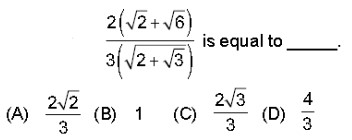
Answer 😀Show Answer :
Question : 1.224 can be expressed as a fraction in simplest form as __.
(a) 450/551
(b) 1224/1000
(c) 551/450
(d) 1000/1224
Answer :CShow Answer :
Question : Given that H.C.F. (306, 954, 1314) = 18, find L.C.M. (306, 954, 1314).
(a) 1183234
(b) 1123238
(c) 1183914
(d) 1123328
Answer :CShow Answer :
Question : If ‘a’ and ‘b’ are rational numbers and 2+√3 / 2-√3 = a+b√3 then (a + b)2 = ……………..
(a) 121
(b) 171
(c) 116
(d) 198
Answer :AShow Answer :
Question :The rationalising factor of 7√x3y5z2 is __.
(a) 7√z5y2x4
(b) 4√x3y2z
(c) √x4y2z5
(d) 3√y2x4z3
Answer :BShow Answer :
Question :Which of the following is an irrational number?
(a) π
(b) 22/7
(c) Both (A) and (B)
(d) Neither (A) nor (B)
Answer 😀Show Answer :
Question : A real number

(A) Terminating decimal expansion
(b) Non-terminating decimal expansion
(c) Repeating decimal expansion
(d) Both (B) and (C)
Answer :AShow Answer :
Question : According to the Fundamental Theorem of Arithmetic, if p (a prime number) divides b2 and b is positive, then __.
(a) b divides p
(b) b2 divides p
(c) p divides b
(d) None of these
Answer :AShow Answer :
Question : In a seminar the number of participants in Mathematics, Physics and Biology are 192, 240 and 168. Find the minimum number of rooms required if in each room same number of participants is to be seated and all of them being in the same subject.
(a) 20
(b) 25
(c) 28
(d) 30
Answer 😀Show Answer :
Question : Sam, Advik and Trishu go for a morning walk. They step off together and their steps measure 35 cm, 32 cm and 40 cm, respectively. What is the minimum distance each should walk so that each can cover the same distance in complete steps?
(a) 1109
(b) 1102
(c) 1100
(d) 1120
Answer :CShow Answer :
Question : A boy was asked to multiply a given number by (8/17). Instead, he divided the given number by (8/17) and got the result 225 more than what he should have got if he had multiplied the number by (8/17). The given number was ________.
(a) 8
(b) 17
(c) 64
Answer :BShow Answer :
Question : Four different electronic devices make a beep after every 30 minutes, 1 hour,1 X 1 / 2 hour and 1 hour 45 minutes respectively. All the devices beeped together at 12 noon. They will again beep together at ________.
(a) 12 midnight
(b) 3 a.m.
(c) 6 a.m.
(d) 9 a.m.
(d) 136
Answer 😀Show Answer :
Question : A boy multiplied 987 by a certain number and obtained 559981 as his answer. If in the answer both 9s are wrong and the other digits are correct, then the correct answer would be ________.
(a) 553681
(b) 555181
(c) 555681
(d) 556581
Answer :CShow Answer :
Question : A boy was asked to multiply a given number by (8/17). Instead, he divided the given number by (8/17) and got the result 225 more than what he should have got if he had multiplied the number by (8/17). The given number was ________.
(a) 8
(b) 17
(c) 64
Answer 😀Show Answer :
Question : Four different electronic devices make a beep after every 30 minutes, 1 hour,1 X 1 / 2 hour and 1 hour 45 minutes respectively. All the devices beeped together at 12 noon. They will again beep together at ________.
(a) 12 midnight
(b) 3 a.m.
(c) 6 a.m.
(d) 9 a.m.
(d) 136
Answer 😀Show Answer :
Question : Which of the following statements is INCORRECT?
(a) For natural numbers a and b, if a divides b2 then a divides b.
(b) For any natural number n, √n −1 + √n +1 is irrational.
(c) Product of distinct prime numbers is always equal to their L.C.M.
(d) For any natural number n, 6n never ends with digit zero.
Answer :AShow Answer :
Question : The three rational numbers between 3 and 4 are:
(a) 5/2, 6/2, 7/2
(b) 13/4, 14/4, 15/4
(c) 12/7, 13/7, 14/7
(d)11/4, 12/4, 13/4
Answer : bShow Answer :
Explanation: There are many rational numbers between 3 and 4
To find 3 rational numbers, we need to multiply and divide both the numbers by 3+1 = 4
Hence, 3 x (4/4) = 12/4 and 4 x (4/4) = 16/4
Thus, three rational numbers between 12/4 and 16/4 are 13/4, 14/4 and 15/4.
Question : 3√6 + 4√6 is equal to:
(a) 6√6
(b) 7√6
(c) 4√12
(d) 7√12
Answer : bShow Answer :
Explanation: 3√6 + 4√6 = (3 + 4)√6 = 7√6
Question : √6 x √27 is equal to:
(a) 9√2
(b) 3√3
(c) 2√2
(d) 9√3
Answer : a = (3 × 3)√2Show Answer :
Explanation:
= 9√2
Question : Which of the following is equal to x3?
(a) x6 – x3
(b) x6.x3
(c) x6/x3
(d) (x6)3
Answer : cShow Answer :
Explanation: x6/x3 = x6 – 3 = x3
Question :) Which of the following is an irrational number?
(a) √23
(b) √225
(c) 0.3796
(d) 7.478478
Answer : aShow Answer :
Explanation: √23 = 4.79583152331…
Since the decimal expansion of the number is non-terminating non-recurring. Hence, it is an irrational number.
But, √225 = 15, 0.3796 and 7.478478 are terminating.
Question : Which of the following is an irrational number?
(a) 0.14
d. 0.4014001400014…
Answer : dShow Answer :
Explanation: 0.4014001400014…is an irrational number as it is non-terminating and non-repeating.
Question : In between any two numbers, there are:
(a) Only one rational number
(b) Two rational numbers
(c) Infinite rational numbers
(d) No rational number
Answer : cShow Answer :
Explanation: Take the reference from question number 2 explained above.
Question : Every rational number is:
(a) Whole number
(b) Natural number
(c) Integer
(d) Real number
Answer : dShow Answer :
Explanation: Real number consist of all the rational and irrational numbers. A rational number is a number that is represented in the form of P/Q, where Q is not equal to zero and both P and Q are integers. For example, 1/2 is a rational number, but not a whole number, a natural number or an integer.
Question : √9 is __________ number.
(a) A rational
(b) An irrational
(c) Neither rational nor irrational
(d) None of the above
Answer : aShow Answer :
Explanation: √9 = 3
Hence, √9 is a rational number.
Question : Which of the following is an irrational number?
(a) √16
(b) √(12/3)
(c) √12
(d) √100
Answer : cShow Answer :
Hence, √12 cannot be simplified to a rational number.
Question : 2√3+√3 =
(a) 6
(b) 2√6
(c) 3√3
(d) 4√6
Answer : cShow Answer :
Explanation: 2√3+√3 = (2+1)√3= 3√3.
Question : The number obtained on rationalising the denominator of 1/ (√7 – 2) is
(a) (√7+2)/3
(b) (√7-2)/3
(c) (√7+2)/5
(d) (√7+2)/45
Answer : aShow Answer :
Explanation:
Question : Which of the following is rational?
(a) 4/0
(b) 0/4
(c) √3
(d) π
Answer : bShow Answer :
Explanation: 0/4 is a rational number that is equal to 0. Whereas π and √3 are irrational numbers and 4/0 is undefined.
Question : The irrational number between 2 and 2.5 is
(a) √11
(b) √5
(c) √22.5
(d) √12.5
Answer : bShow Answer :
Explanation: The irrational number between 2 and 2.5 is √5 because the approximate value of √5 is 2. 23606…
Question : The value of √10 times √15 is equal to
(a) 5√6
(b) √25
(c) 10√5
(d) √5
Answer : aShow Answer :
Explanation: √10×√15 =(√2.√5)×(√3. √5) = (√5 × √5) (√2 × √3) = 5√6.
Question : The decimal representation of the rational number is
(a) Always terminating
(b) Either terminating or repeating
(c) Either terminating or non-repeating
(d) Neither terminating nor repeating
Answer : bShow Answer :
Explanation: As per the definition of rational number, its decimal representation is either terminating or repeating.
Question : Which of the following is a rational number?
(a) 0
(b) 2√3
(c) 2+√3
(d) π
Answer : aShow Answer :
Explanation: 0 is a rational number, and it can be written as 0/1 or 0/2 or 0/3 etc. Whereas 2√3, 2+√3, and π are irrational numbers.
Question : Which of the following is an irrational number?
(a) √(4/9)
(b) √12/√3
(c) √7
(d) √81
Answer : c √81 = 9Show Answer :
Explanation: √7 is an irrational number. Because other options given are simplified into a rational number.
Question :If x = 2+√3, then x +
(a) 5
(b) 4
(c) -4
(d) -5
Answer : (b) 4Show Answer :
Question :The three rational numbers between 3 and 4 are:
(a)
(b)
(c)
(d)
Answer : (b) Show Answer :
Question :Decimal representation of a rational number cannot be
(a) terminating
(b) always terminating
(c) always non-terminating
(d) non terminating non repeating
Answer : (d) non terminating non repeatingShow Answer :
Question :All the integers are
(a) whole numbers
(b) rational numbers
(c) irrational numbers
(d) natural numbers
Answer : (b) rational numbersShow Answer :
Question :Every real number is
(a) neither rational nor irrational
(b) irrational
(c) rational
(d) either rational or irrational
Answer : (d) either rational or irrationalShow Answer :
Question :In between any two numbers there are:
(a) Only one rational number
(b) Many rational numbers
(c) Infinite rational numbers
(d) No rational number
Answer : (c) Infinite rational numbersShow Answer :
Question :Every rational number is:
(a) Whole number
(b) Natural number
(c) Integer
(d) Real number
Answer : (d) Real numberShow Answer :
Question :(64)
(a)
(b)
(c) 64
(d)
Answer : (a) Show Answer :
Question : The product of a rational and an irrational numbers is:
(a) Always an integer
(b) Always a rational number
(c) Always an irrational number
(d) Sometimes rational and sometimes irrational
Answer :(c) Always an irrational numberShow Answer :
Question : Which of the following is Natural number?
(a) 3.5
(b) 7
(c) 0
(d) -2
Answer :(b) 7Show Answer :
Question : Which of the following is an irrational number?
(a) √16
(b) √(12/3)
(c) √12
(d) √100
Answer :(c) √12Show Answer :
Question : (√a + √(ii) (√a – √(ii) is
(a) a + b
(b) a – b
(c) 2√a
(d) 2√b
Answer :(b) a – bShow Answer :
Question : √6 x √27 is equal to:
(a) 9√2
(b) 3√3
(c) 2√2
(d) 9√3
Answer :(a) 9√2Show Answer :
Question : The value of 491/2 is equal to
(a) 1/49
(b) 49
(c) 7
(d) 1/7
Answer :(c) 7Show Answer :
Question : The value of (67.542)² −(32.458)² /75.458 − 40.374 is
(a) 100
(b) 1
(c) 10
(d) none
Answer :(a) 100Show Answer :
Question : If the HCF of 65 and 117 is expressible in the form 65m – 117, then the value of m is
(a) 4
(b) 2
(c) 1
(d) 3
Answer :(b) 7Show Answer :
Question : In between any two numbers there are:
(a) Only one rational number
(b) Many rational numbers
(c) Infinite rational numbers
(d) No rational number
Answer :(c) Infinite rational numbersShow Answer :
Question : The decimal expansion of √2 is
(а) finite decimal
(b) 1.4121
(c) non-terminating recurring
(d) non-terminating non-recurring
Answer :(d) non-terminating non-recurringShow Answer :
Question : In between any two numbers there are:
(a) Only one rational number
(b) Many rational numbers
(c) Infinite rational numbers
(d) No rational number
(iii) Infinite rational numbers
Answer :AboveShow Answer :
Question : The rational number between 1 and 2 is
(a) 3/2
(b) 7/2
(c) 5/2
(d) 1/2
Answer :(a) 3/2Show Answer :
Question : If x/y= 6/5 then x² + y² / x² − y²
(a) 36/25
(b) 25/36
(c) 61/11
(d) 11/61
Answer :(a) 36/25Show Answer :
Question : The product of a rational and an irrational numbers is:
(a) Always an integer
(b) Always a rational number
(c) Always an irrational number
(d) Sometimes rational and sometimes irrational
Answer :(c) Always an irrational numberShow Answer :
Question : (-7+4√7-3√7) is
(a) a positive rational number
(b) an irrational number
(c) a negative rational number
(d) equal to zero
Answer :(b) an irrational numberShow Answer :
Question : 3√6 + 4√6 is equal to:
(a) 6√6
(b) 7√6
(c) 4√12
(d) 7√12
Answer :(b) 7√6Show Answer :
Question : √6 x √27 is equal to:
(a) 9√2
(b) 3√3
(c) 2√2
(d) 9√3
Answer :(a) 9√2Show Answer :
Question : If x1/12 = 491/24 then find the value of x.
(a) 49
(b) 2
(c) 12
(d) 7
Answer :(d) 7Show Answer :
Question : Match the following.
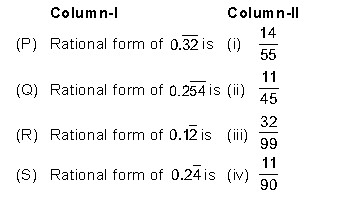
(A) (P) → (iii); (Q) → (iv); (R) → (i); (S) → (ii)
(b) (P) → (iv); (Q) → (i); (R) → (ii); (S) → (iii)
(c) (P) → (iii); (Q) → (i); (R) → (iv); (S) → (ii)
(d) (P) → (i); (Q) → (iii); (R) → (iv); (S) → (ii)
Answer :CShow Answer :
Question : A charitable trust donates 28 different books of Maths, 16 different books of Science and 12 different books of Social is given maximum number of books of only one subject of their interest and each student got equal number of books.
(a) Find the number of books each student got.
(b) Find the total number of students who got books.
(a) (b)
(a) 4 14
(b) 3 10
(c) 4 10
(d) 3 15
Answer :AShow Answer :
Question : Read the statements carefully and state ‘T’ for true and ‘F’ for false.
(i) 501/25 is a terminating decimal.
(b) 621/125 is a non-terminating decimal.
(c) 6805/27 × 52 is a non-terminating decimal.
(d) 7105/7 × 52 is a terminating decimal.
(i) (ii) (iii) (iv)
(a) F T T F
(b) T F T T
(c) T T F F
(d) F T F T
Answer :BShow Answer :
Question : Can we write 0 in the form of p/q?
(a) Yes
(b) No
(c) Cannot be explained
(d) None of the above
Answer : aShow Answer :
Explanation: 0 is a rational number and hence it can be written in the form of p/q.
Example: 0/4 = 0
Question : Which of the following lies between 0 and -1?
(a) 0
(b) -3
(c) -2/3
(d) 4/3
Answer :(c) -2/3Show Answer :
Question : Which of the following statement is true
(a) x° = 1/x
(b) x° = x
(c) x° = 0
(d) x° = 1
Answer :(d) x° = 1Show Answer :
Question : The sum of the powers of the prime factors in 108 × 192 is
(a) 12
(b) 7
(c) 5
(d) 8
Answer :(a) 12Show Answer :
Question : Decimal representation of a rational number cannot be
(a) terminating
(b) always terminating
(c) always non-terminating
(d) non terminating non repeating
Answer :(d) non terminating non repeatingShow Answer :
Question : Which of the following are irrational numbers?
(a) √23
(b) √225
(c) 0.3796
(d) 7.478478
Answer :(a) √23Show Answer :
Question : How many zeros after the decimal point will be there in the decimal form of the number 10-n ?
(a) n
(b) n+1
(c) n-1
(d) n/2
Answer :(c) n-1Show Answer :
